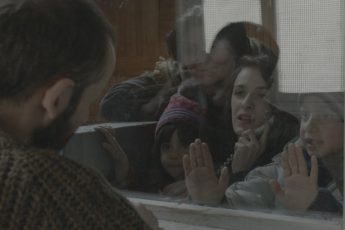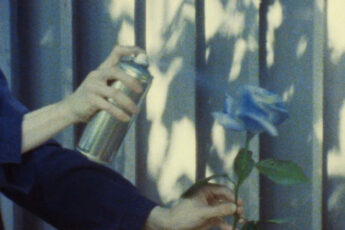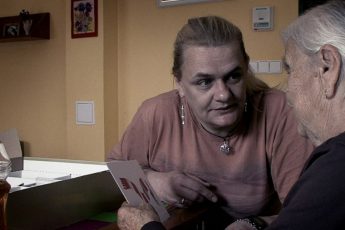A Landscape of Faces
Paweł Łoziński’s You Have No Idea How Much I Love You (Nawet nie wiesz jak bardzo Cię kocham, 2016)
Vol. 76 (Summer 2017) by Zoe Aiano
Formally, Paweł Łoziński’s latest documentary You Have No Idea How Much I Love You creeps towards the edge of cinematic minimalism. With the mise-en-scene consisting exclusively of close-ups against a grey-blue background, three cameras remain firmly fixed on three characters in dialog in a room. Specifically, these are a mother, Ewa, a daughter, Hania, and their therapist, Bogdan De Barbaro, and the action, for want of a more appropriate word, takes place over the course of several therapy sessions, depicted in chronological order. This pared-down simplicity induces something of a hypnotic state, allowing for the protagonists’ emotions to be foregrounded by eliminating any other possible distractions.
To use Łoziński’s own expression, the film is something of an ode to the “landscape of the face,” and during the dialogs the reactions of the listeners are given equal status to the pronouncements of the speakers. However, while the face certainly dominates as the only part actually seen, the body as a whole plays an important role in conveying meaning. Minute gestures, glances, hesitations and vocal fluctuations acquire an exaggerated precedence, and indeed the physical manifestation of emotion and trauma is one of the leitmotifs that runs throughout the discussions. As an extension of this, another undercurrent is the expressive limitation of words, with both mother and daughter often resorting to clumsy metaphors and constantly retracting their choice of phrasing when pressed for clarification. Sentences are not allowed to go unfinished under the attentive moderation of Professor De Barbaro.
The topics covered during the sessions are those you would expect given the mother-daughter pairing. Their stated motivation for attending therapy is an inability to communicate, and the accusations that follow are structured through the contested dichotomies of smothering vs. abandonment, dependence vs. independence and expectation vs. disappointment. Our knowledge of their relationship slowly increases on a bread-crumb basis, with both parties revealing themselves to be suffering from long-lasting scars from childhood and the experience of divorce. Emotions run high at all times, and tears are frequently shed. Often one party speaks at length while the other is forced to listen awkwardly. Only the therapist remains a calm, consistent presence, with his authoritative eyebrows and empathetic, piercing gaze.
The film is not predicated on any kind of shock revelation, but lingers instead on details and nuance, without the imposition of grand narratives or dramaturgical obligations. Nor is there any pretense of having made a breakthrough, and while there is some sense of development by the time the sessions end, nothing is magically resolved. The penultimate session ends tellingly with the voice of the mother announcing that she thinks they’ll manage to find a way, while the face of the daughter seems anything but convinced. Nevertheless, as the daughter summarizes, they may not go shopping together, but she has at least come to see her mother as a more rounded individual.
If this whole premise seems inappropriately intimate or invasive, then the good news is that the pair in question are not actually related. Professor De Barbaro is a genuine therapist, and follows his usual approach (in fact, he has started using the film with students as an example of his methods in action) and there was no script, so in a certain extent the therapy was “real”. This poses the interesting question of what difference it would have actually made to have a biologically related pair. The two women were drawing on their own personal experiences in any case, and this itself makes a poignant statement about the universality of the topics addressed. If two people with no previous connection can each talk about their own lives in a way that convincingly implies them to be shared, then clearly there must be common threads running through human relations. Indeed, while not all audiences will appreciate the film’s premise, it is hard to imagine anyone who would find at least some moments of resonance.
The use of this device is revealed at the end of the film, in keeping with a current tendency to withhold vital information until the final credits. However, You Have No Idea How Much I Love You is a rare example of a film that bears re-watching even after the twist has been revealed, and indeed offers a new reading for those interested enough to sit through 80 minutes of incessant talking heads twice. Moreover, choosing to divulge this information at the end avoids the temptation of drifting away from what is presented onscreen and into the realm of imagining what is “true” and what is not. Overall, the film’s strengths totally justify the use of this artifice, preventing it from becoming mere gimmickry and falling into the trap of becoming more interesting for its approach than for its content.




Leave a Comment